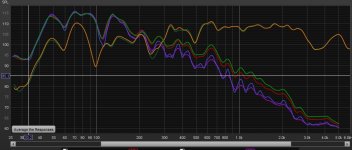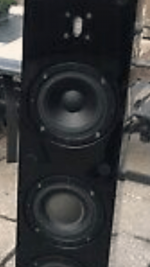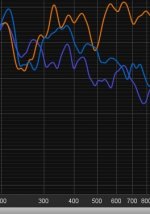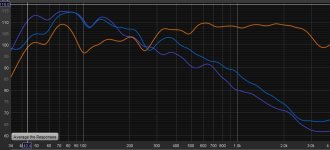dear sirs,
i have taken various measurements of different component values on a 3 way xover I'm creating , these graphs are for the bass + mid only
im not too sure as to which slopes i will select, do i go for the bass slope with higher output in the 200-800hz range , or choose the slopes with lower output in this range? there are 4 different slopes for the bass .... any help appreciated.
ps: the xover point is 200hz ( These are in room measurements using the various components i used )
i have taken various measurements of different component values on a 3 way xover I'm creating , these graphs are for the bass + mid only
im not too sure as to which slopes i will select, do i go for the bass slope with higher output in the 200-800hz range , or choose the slopes with lower output in this range? there are 4 different slopes for the bass .... any help appreciated.
ps: the xover point is 200hz ( These are in room measurements using the various components i used )
Attachments
Last edited:
An Interesting question.
200Hz crossover what crossover type are you favouring 1st or 2nd ?
Does the software you use allow you to show the target slope of the crossover, then you can match your responses for the best fit.
Looking at it in another way, how do each of your slopes affect the mid range response the least, can you drive it in that mode? If so the the option that gives the flattest response or alternatively does not change the mid response may be a suitable starting point.
I am guessing you may need to bring the midrange level down a little more as you tune this .
Maybe some more info on purpose and drivers may be helpful to get a better understanding
200Hz crossover what crossover type are you favouring 1st or 2nd ?
Does the software you use allow you to show the target slope of the crossover, then you can match your responses for the best fit.
Looking at it in another way, how do each of your slopes affect the mid range response the least, can you drive it in that mode? If so the the option that gives the flattest response or alternatively does not change the mid response may be a suitable starting point.
I am guessing you may need to bring the midrange level down a little more as you tune this .
Maybe some more info on purpose and drivers may be helpful to get a better understanding
the problem is, i dont know what the drivers are, no labels, so doing this purely. on the measurements + trial and error
its a 2nd order on woofer , and a bandpass on the mid. ( originally the mid has no xover, it was sold like this , but the 5.5" mid driver was ringing at higher volumes, so a band pass was needed....
i dont know the baffle step, all i know is its a ported design, tuned at 45hz
'I am guessing you may need to bring the midrange level down a little more as you tune this'
so you recommend i choose the mid slope that has the lowest SPL ?
its a 2nd order on woofer , and a bandpass on the mid. ( originally the mid has no xover, it was sold like this , but the 5.5" mid driver was ringing at higher volumes, so a band pass was needed....
i dont know the baffle step, all i know is its a ported design, tuned at 45hz
'I am guessing you may need to bring the midrange level down a little more as you tune this'
so you recommend i choose the mid slope that has the lowest SPL ?
The bass woofer values are 2nd order:- 4.3mH + 120uF / 150 / 200 / 250 / 300uF. ( The higher the shunt capacitor i used , the steeper the slope )
Dual 5.25" bass woofers running in parallel
midrange bandpass is 3.2mH + 200 /235uF ( but its only 12db quieter at 70hz compared to bass....) I think i will need to try a 12db/octave bandpass
Dual 5.25" bass woofers running in parallel
midrange bandpass is 3.2mH + 200 /235uF ( but its only 12db quieter at 70hz compared to bass....) I think i will need to try a 12db/octave bandpass
Attachments
Last edited:
Based on this it seems the filters would range from 140Hz/Q=1 to 220Hz/Q=0.7 These are not bad choices. Based on looking at the level at the filter frequency and the attenuation two octaves above, they seem to be doing their job.
At the same time they seem to be rather similar, as if influenced by something else. So which would be better? First I'd try them all, it may seem like it's a matter of getting the amount of bass right. However if you come to the conclusion that something still isn't right, you'll have three immediate choices.
One is to try a different inductor value, another is to modify the mid. The third is one that has been mentioned, and that's to set a target slope in a crossover simulator and try to take more control over what you get.
At the same time they seem to be rather similar, as if influenced by something else. So which would be better? First I'd try them all, it may seem like it's a matter of getting the amount of bass right. However if you come to the conclusion that something still isn't right, you'll have three immediate choices.
One is to try a different inductor value, another is to modify the mid. The third is one that has been mentioned, and that's to set a target slope in a crossover simulator and try to take more control over what you get.
thanks, thats really helpful info , the mid seems fine down to 250hz , and then a huge peak 100-70hz, ( likely room interaction - but SPL seems too high at those frequencies? ) and below 100hz it seems to be only a slightly quieter copy of the woofer response..... i will remeasure , as i dont understand how this mid is only 7db quieter at 40hz?
Your mid response is generally lower than the woofer's, which is about right if you're trying to manage the baffle step by splitting it between the two. When doing that you may have to think in terms of the curves being asymmetric, with the combined response sloping up around the crossover.
Now, if you draw a smooth curve over the mid response from about 400hz to 120Hz, it would cut out the dip at 250Hz which appears to be a mode. I'm thinking it would look more right if that mode wasn't there. However I suggest you do this mentally until you can work out what is causing it. Some modes are less harmful than they look and some aren't.
100Hz seems to be a modal dip, not a crossover rolloff. 70Hz is a modal peak. It may be OK, or it may do with a little more attenuation, it's hard to say.
Now, if you draw a smooth curve over the mid response from about 400hz to 120Hz, it would cut out the dip at 250Hz which appears to be a mode. I'm thinking it would look more right if that mode wasn't there. However I suggest you do this mentally until you can work out what is causing it. Some modes are less harmful than they look and some aren't.
100Hz seems to be a modal dip, not a crossover rolloff. 70Hz is a modal peak. It may be OK, or it may do with a little more attenuation, it's hard to say.
If you are going do re do the measurement's can you possibly measure the drivers impedances and then we could at least match up the Xover values as being on target.
The bump at approx. 650Hz in the orange (overall response)? As you tune the bass capacitor values does it lessen the bump. I ask as this may be an indication that you need a steeper Xover slope to stop the falling bass response adding to midrange level.
Good luck with the new measurement's, as you say you have a few more things to discover with these speakers
The bump at approx. 650Hz in the orange (overall response)? As you tune the bass capacitor values does it lessen the bump. I ask as this may be an indication that you need a steeper Xover slope to stop the falling bass response adding to midrange level.
Good luck with the new measurement's, as you say you have a few more things to discover with these speakers
excellent , thanks..... based on your info my next step will be to reposition the speakers to the centre of my room + remeasure . hopefully that may reduce / modify the 250hz room mode + give me a better idea of whats going on at the lower freq.s.
and will be interesting to see if that 70hz peak remains
and will be interesting to see if that 70hz peak remains
'If you are going do re do the measurement's can you possibly measure the drivers impedances and then we could at least match up the Xover values as being on target.'
the woofers combined are 3.3DCR ( and then inductor is 0.8R ) .... the mid is 6.6 (inductor 0.5R )
The bump at 650hz doesnt change as such, when using higher value cap.s the whole slope drops off steeper at the xover point, but each slope still has the 650 bump
the woofers combined are 3.3DCR ( and then inductor is 0.8R ) .... the mid is 6.6 (inductor 0.5R )
The bump at 650hz doesnt change as such, when using higher value cap.s the whole slope drops off steeper at the xover point, but each slope still has the 650 bump
Attachments
Last edited:
i did previously test with a 5mh inductor + 130uf cap, see graph ( blue line ) ....the 650 bump is gone , however the slope is less steep than the 4.3mh, so my preference was for the 4.3mh slope , so less SPL after the 200hz xover point,
orange line is the mid.
orange line is the mid.
Attachments
Last edited:
Is there a special reason for a 200 Hz crossover? As this is a small width cab you can fairly move up the xo point. This will ease the mid. Look also if the 70Hz mid peak goes away.
The baffle step frequency depends only on the baffle width (115/width in meters), and I'd aim at a xo point around this value.
Ralf
The baffle step frequency depends only on the baffle width (115/width in meters), and I'd aim at a xo point around this value.
Ralf
'100Hz seems to be a modal dip, not a crossover rolloff. 70Hz is a modal peak'
thats really good to hear, in which case i think the midrange freq.res. seems pretty good right now.... ( if i mentally erase the room dip/peak ) ...
thats really good to hear, in which case i think the midrange freq.res. seems pretty good right now.... ( if i mentally erase the room dip/peak ) ...
'Is there a special reason for a 200 Hz crossover? As this is a small width cab you can fairly move up the xo point. This will ease the mid'
thats a good question, basically id like to keep the full vocal range within one driver ...... also, this speaker model never used any xover for the mid driver, it was run full range....so my thinking is it should perform better with a 200-3500hz bandpass
the original xover for the woofers was 4.3mh + 60uF, but the bass was a bit strong in room, so I looked for a steeper slope
baffle step freq. = 575hz
thats a good question, basically id like to keep the full vocal range within one driver ...... also, this speaker model never used any xover for the mid driver, it was run full range....so my thinking is it should perform better with a 200-3500hz bandpass
the original xover for the woofers was 4.3mh + 60uF, but the bass was a bit strong in room, so I looked for a steeper slope
baffle step freq. = 575hz
Last edited:
Maybe a bit late if todays measurement's are over. But have you tried to invert the phasing of the mid. That should give you a new peak or dip or may reveal how well the integration between the drivers is progressing.
Do you ever export you measurements to a design package such as Xsim or Vituixcad. Maybe you have another favourite tool ?
Do you ever export you measurements to a design package such as Xsim or Vituixcad. Maybe you have another favourite tool ?
'be a bit late if todays measurement's are over. But have you tried to invert the phasing of the mid. That should give you a new peak or dip or may reveal how well the integration between the driversis progressing'.'
ah yes of course, i completely forgot about that , thanks !
i havent started remeasuring , so plenty time.... i dont know what the drivers are , so cant use any software
ah yes of course, i completely forgot about that , thanks !
i havent started remeasuring , so plenty time.... i dont know what the drivers are , so cant use any software
If you can measure both frequency response and impedance vs frequency, then software like XSim or VituixCAD doesn't need to know what model the drivers are - they'll work directly from the measurements.
- Home
- Loudspeakers
- Multi-Way
- help needed choosing one of these xover slopes ( graphs attached )




